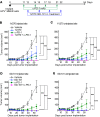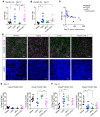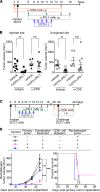Combination immunotherapy with TLR agonists and checkpoint inhibitors suppresses head and neck cancer
- PMID: 28931759
- PMCID: PMC5621908
- DOI: 10.1172/jci.insight.93397
Combination immunotherapy with TLR agonists and checkpoint inhibitors suppresses head and neck cancer
Abstract
Checkpoint inhibitors have demonstrated efficacy in patients with recurrent or metastatic head and neck squamous cell carcinoma (HNSCC). However, the majority of patients do not benefit from these agents. To improve the efficacy of checkpoint inhibitors, intratumoral (i.t.) injection with innate immune activators, TLR7 and TLR9 agonists, were tested along with programmed death-1 receptor (PD-1) blockade. The combination therapy suppressed tumor growth at the primary injected and distant sites in human papillomavirus-negative (HPV-negative) SCC7 and MOC1, and HPV-positive MEER syngeneic mouse models. Abscopal effects and suppression of secondary challenged tumor suggest that local treatment with TLR agonists in combination with anti-PD-1 provided systemic adaptive immunity. I.t. treatment with a TLR7 agonist increased the ratio of M1 to M2 tumor-associated macrophages (TAMs) and promoted the infiltration of tumor-specific IFNγ-producing CD8+ T cells. Anti-PD-1 treatment increased T cell receptor (TCR) clonality of CD8+ T cells in tumors and spleens of treated mice. Collectively, these experiments demonstrate that combination therapy with i.t. delivery of TLR agonists and PD-1 blockade activates TAMs and induces tumor-specific adaptive immune responses, leading to suppression of primary tumor growth and prevention of metastasis in HNSCC models.
Keywords: Cancer immunotherapy; Head & neck cancer; Immunology.
Conflict of interest statement
Figures








Similar articles
-
In situ immunization of a TLR9 agonist virus-like particle enhances anti-PD1 therapy.J Immunother Cancer. 2020 Oct;8(2):e000940. doi: 10.1136/jitc-2020-000940. J Immunother Cancer. 2020. PMID: 33060147 Free PMC article.
-
Intratumoral immunotherapy with TLR7/8 agonist MEDI9197 modulates the tumor microenvironment leading to enhanced activity when combined with other immunotherapies.J Immunother Cancer. 2019 Sep 11;7(1):244. doi: 10.1186/s40425-019-0724-8. J Immunother Cancer. 2019. PMID: 31511088 Free PMC article.
-
Tumor hypoxia is associated with resistance to PD-1 blockade in squamous cell carcinoma of the head and neck.J Immunother Cancer. 2021 May;9(5):e002088. doi: 10.1136/jitc-2020-002088. J Immunother Cancer. 2021. PMID: 33986123 Free PMC article.
-
Programmed Death-1/Programmed Death-Ligand 1-Axis Blockade in Recurrent or Metastatic Head and Neck Squamous Cell Carcinoma Stratified by Human Papillomavirus Status: A Systematic Review and Meta-Analysis.Front Immunol. 2021 Apr 7;12:645170. doi: 10.3389/fimmu.2021.645170. eCollection 2021. Front Immunol. 2021. PMID: 33897693 Free PMC article.
-
Head and Neck Cancer Immunotherapy beyond the Checkpoint Blockade.J Dent Res. 2019 Sep;98(10):1073-1080. doi: 10.1177/0022034519864112. Epub 2019 Jul 24. J Dent Res. 2019. PMID: 31340724 Free PMC article. Review.
Cited by
-
Combination Therapy with a TLR7 Agonist and a BRD4 Inhibitor Suppresses Tumor Growth via Enhanced Immunomodulation.Int J Mol Sci. 2024 Jan 4;25(1):663. doi: 10.3390/ijms25010663. Int J Mol Sci. 2024. PMID: 38203835 Free PMC article.
-
Role of lysosomes in physiological activities, diseases, and therapy.J Hematol Oncol. 2021 May 14;14(1):79. doi: 10.1186/s13045-021-01087-1. J Hematol Oncol. 2021. PMID: 33990205 Free PMC article. Review.
-
Modulation of Type I Interferon Responses to Influence Tumor-Immune Cross Talk in PDAC.Front Cell Dev Biol. 2022 Feb 22;10:816517. doi: 10.3389/fcell.2022.816517. eCollection 2022. Front Cell Dev Biol. 2022. PMID: 35273962 Free PMC article. Review.
-
Adaptive immune resistance at the tumour site: mechanisms and therapeutic opportunities.Nat Rev Drug Discov. 2022 Jul;21(7):529-540. doi: 10.1038/s41573-022-00493-5. Epub 2022 Jun 14. Nat Rev Drug Discov. 2022. PMID: 35701637 Review.
-
My journey from tyrosine phosphorylation inhibitors to targeted immune therapy as strategies to combat cancer.Proc Natl Acad Sci U S A. 2019 Jun 11;116(24):11579-11586. doi: 10.1073/pnas.1816012116. Epub 2019 May 10. Proc Natl Acad Sci U S A. 2019. PMID: 31076554 Free PMC article.
References
Publication types
MeSH terms
Substances
Grants and funding
LinkOut - more resources
Full Text Sources
Other Literature Sources
Medical
Research Materials

